Long on hair, short on brains.
French Proverb
At the base of a hair follicle cells expressing high amounts of keratin proteins, multiply, push upward and die, to form a shaft of hair. The three types of hair produced by the body are lanugo, vellus and terminal. Terminal hairs are found on the scalp, pubic area and other body areas such as the armpits, lanugo hair is specific to the foetal development while velus hair is the very fine light – almost invisible – hair.
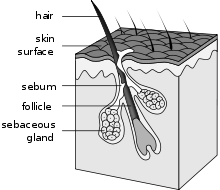

The most common cause of loss of head hair is androgenic alopecia, while a complete loss of scalp hair at a very young is known as alopecia areata totalis and a loss of all body hair is termed alopecia areata universalis.
The production of either too much terminal hair or lanugo hair is known as hypertrichosis terminalis (Gr. hyper; excess, trichos; hair) and hypertrichosis lanuginose, respectively.
Disruptions in the shape of hair can lead to it either being highly fragile such as monilethrix (Gr. monile, necklace; thrix, hair), twisted and kinky such as in pili torti (Lat. pili, hair; torti, twisted), forming bamboo-like fragile nodules (trichorrhexis invaginata) or becoming very curly (woolly hair syndromes).
Hair colour, like skin colour, derives from melanin. Albinism results in white hair, while a loss of hair colour during older age is known as canities (Lat. canus; grey) and the appearance of white hairs in early adulthood is known as premature greyness. The appearance of white hair at specific locations, such as a white forelock, may rarely signify a number of genetic disorders, such as Piebaldism and Waardenberg.


Various shades of red hair result from differences in genes controlling melanin.
Androgenetic Alopecia
Androgenetic alopecia (Gr. alopex; fox – an animal that frequently suffers a contagious scabies-like dermatitis, caused by mites, which leads to hair loss) results from alterations in male hormones (androgens), that cause hair follicles in the scalp to decrease in size later in life, and genetic factors.

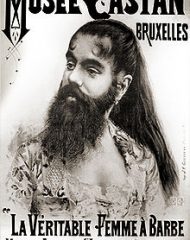
The role of androgens in hair loss probably first became evident from the fact that eunuchs never seemed to go bald. Women also only rarely develop androgenic alopecia, though in the cases of abnormally high levels of testosterone, they not only go bald, but also tend to grow beards, known as hirsutism.
The role of androgens in hair loss probably first became evident from the fact that eunuchs never seemed to go bald. Women also only rarely develop androgenic alopecia, though in the cases of abnormally high levels of testosterone, they not only go bald, but also tend to grow beards, known as hirsutism.

Alopecia Areata Totalis

Alopecia areata occurs upon the loss of discrete regions of hair from the scalp. The condition is then described as alopecia areata totalis where all scalp hair is lost in a relatively short time and at a relatively young age. There seems to be some familial basis and there are some thoughts that the condition may result from an autoimmune reaction.
Pierluigi Collina, the Italian football referee, suffered from this losing all his hair in the space of just two weeks when he was 24.
Scottish television presenter, Gail Porter, developed alopecia areata totalis at the age of 34, though refused to wear a hat or wig, deciding instead to maintain a public profile and raise awareness of the condition.

Alopecia Universalis

Alopecia universalis results in the loss of all hair on the head and body, usually quite early in life. This appears to result from an autoimmune reaction though some cases are genetic with some families inheriting this condition as an autosomal recessive trait.
This condition affects British actor and comedian Matt Lucas, who lost every hair on his body around the age of 6. New Zealand Model Anna Fitzpatrick, and British swimmer Duncan Goodhew also suffer among many further well-known individuals.
Hypertrichosis lanuginose
Hypertrichosis (Gr. hyper; excess, trichos; hair) lanuginose results in lanugo hair remaining on all parts of the body. Lanugo hair is grown in utero and lost during pregnancy, except in this genetic condition where the hair keeps on growing throughout life.
One of the first recorded cases was of a boy called Petrus Gonzalez, covered from head to toe in blond hair. Born on Tenerife in 1556 he was “given” to the French King, Henry II King where he went on to marry and raise several children, some of whom also shared his condition, suffering similar fates to a number of other affected people, being displayed like wild animals at circuses and sideshows.

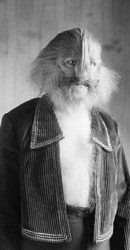
Stephan Bibrowsky, known as Lionel, the Lion-Faced Boy, was born in Poland in 1890 before moving to the USA he was one of the top circus attractions. It was claimed that his mother saw his father ripped to shreds by lions during her pregnancy resulting in his appearance.
Fedor Jeftichew, known as Jo-Jo the Dog-Faced Boy was born in St. Petersburg in 1868 to a father with the same condition. As a circus act, the story was that a hunter found them in a cave as savages, and they could not be tamed, at which point they would growling at the audience who were oblivious to the fact that Fedor was perfectly fluent in several languages.
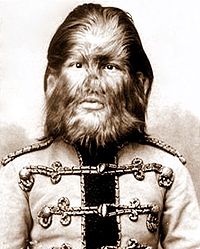
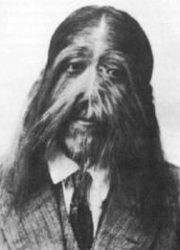
Born in China in 1849, Tai Djin was immediately abandoned in a forest to die by his family who must have been shocked with his condition. However, a Shaolin monk travelling through the forest discovered him lying amongst the trees and took him back to the Shaolin Temple where he was raised by monks who taught him martial arts. Tai Djin proved to be exceptionally gifted and quickly become a favourite of many of the Shaolin masters who each passed their knowledge on to him. Consequently, Tai Djin became the first Grandmaster of Shaolin and the first to master all skills of the seven Shaolin temples, including over 200 different empty hand systems, over 140 weapon systems, and specialties such as the infamous Chi Ma, or Death Touch. Still revered around the world, he lived until the age of 79 and taught many others to be masters.
Hypertrichosis Terminalis
Hypertrichosis terminalis describes the uncontrolled growth of dark terminal hair over the body. This condition also usually presents with enlarged gums and a number of other facial characteristics and appears to be dominantly inherited.
Julia Pastrana, born in Mexico in 1854 with this condition was sold into marriage by her mother to Theodor Lent who exhibited her around the world in various circuses as The Ape Woman. Unknown to many, she was actually a highly intelligent woman who spoke several languages and was an accomplished musician. When 26 years old she gave birth to a boy with the same disorder – he lived only thirty-five hours and Julia Pastrana herself died five days later. Her husband then promptly had the bodies of his wife and son mummified and carried on exhibiting them. Incredibly, during one of the tours Mr Lent met and married another woman with a similar condition to Julia whom he introduced during his acts as “Zenora Pastrana” a sister of Julia. Some time later Theodor Lent suffered a mental breakdown and died in an asylum, while Zenora continued touring with the mummies before selling these to the owner of a shop of oddities in Oslo. The bodies then fell into Nazi hands, where they again went on tour until they were again rediscovered in the Oslo Forensic Institute.
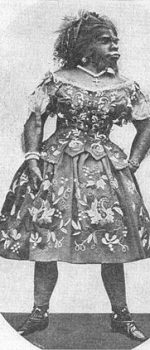
Monilethrix
Monilethrix (Gr. Monile, necklace; thrix; hair) weakens the hair shaft leading to diffusive hair loss, generally at the back of the scalp and neck whereas the front of the head remains relatively unaffected. Though, genetically inherited the effects vary from person to person in a same family with severity diminishing with age.
Pili Torti
Pili torti (Lat: pili, hair; torti, twisted) describes rigidly twisted hair through 180 degrees, leading to fractures hair shaft.
The common cause is genetics and can be seen in a number of hair dystrophies and associated with several syndromes involving defects in keratin formation. Sulphur is important for the structure of keratin proteins, low levels of which can lead to trichothiodystrophy disease, resulting in weakened hairs. Keratin also contains the amino acid arginine, and low levels of this underlie Sabinas Brittle Hair syndrome first observed in a small Mexican town called Sabinas. Keratin formation also relies on the presence of copper, genetic disruptions in the control of which can lead to Menkes kinky hair syndrome.
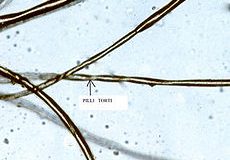
Trichorrhexis Invaginata
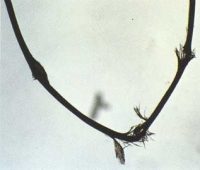
Trichorrhexis invaginata (Gr. Trichos, hair; rhexis, fracture) is often known as “Bamboo hair” as under a microscope, the hair shaft looks like a stalk of bamboo. Resulting from abnormal keratin production the shaft telescopes in on itself (invaginates) at several points along the shaft.
This may occur sporadically, either in normal hair or with other hair shaft abnormalities, or regularly as a marker for the genetic disorder Netherton’s syndrome.
Red Hair
Alpha-Melanocyte-stimulating hormone (alpha-MSH) is a hormone that binds to receptors, such as the melanocyte-stimulating hormone receptor 1 (MC1R) on melanocytes, causing the cell to produce eumelanin.
A lack of alpha-MSH results in the melanocytes not being stimulated and, instead, producing phaeomelanin leading to red/blond hair.
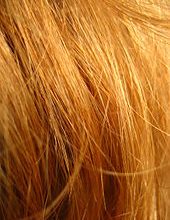
This can also associate with obesity because as well as binding to the MC1R receptor, alpha-MSH also binds to another receptor called MC4R in the brain that controls appetite. However, only a small proportion of redheads are overweight because the majority of individuals producing phaeomelanin do not contain mutations in the alpha-MSH gene, but contain alterations in the MC1R receptor gene.


ThisMC1R receptor gene exists in many different mutant forms differing in their activities, which in a variety of combinations cause the different colours of hair from red, to auburn, to strawberry blond. A majority of the red-headed Celts have receptors that are almost totally inactive.






It is interesting that red hair is most commonly found in people of Scandinavian descent and it is thought that the clusters of redheads in the British Isles derive from Viking or Pictish ancestry. Scotland has the highest proportion of redheads of any country with 13% of the population having red hair and a further 40% carrying the highly inactive MC1R variant gene. It may be that the high occurrence or red-hair, particularly in northern Europe, is due to evolution selecting for red-headed people, because their accompanying lighter skin allows them to absorb more sunlight for vitamin D production.

